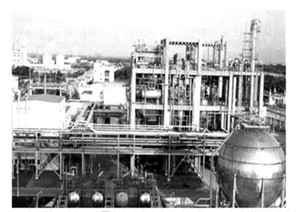PPC Plant
 |
PPC (polypropylene carbonate) is a completely biodegradable environment-friendly plastic synthesized from carbon dioxide and propylene oxide. Besides, due to its using the main source of greenhouse gases---CO2 as the feedstock, PPC not only reduces the emission of greenhouse gases, but also reduces the consumption of fossil fuel. Compared to the degradable PLA(polylactide), it has advantages of high strength, good ductility, lower production cost and etc. PPC polyol with low molecular weight are used to replace conventional petroleum-based polyether, polyester and polycarbonate polyols, while PPC with high molecular weight are employed as film products, oxygen barrier material, injection molding material and etc., especially in package industry and agriculture.
SL TEC offers high molecular weight PPC production technology, with the development history as below:
In 1998, the research of CO2 based plastic began;
In 2001, the first over 1,000TPA PPC pilot line was built and successfully accepted;
In 2012, 30,000TPA PPC production line was built and successfully put into production;
In 2013, the technology was upgraded to increase the molecular weight to 300,000;
In 2016, a 30,000TPA PPC plant using new technology is under construction
Technical Features:
1. The number-average molecular weight of PPC using our technology reaches about 100,000, achieving the most advanced level in the world.
2. The tertiary catalyst ensures shorter polymerization time, i.e., 8 hrs, and within 8 hours the catalyst activity can reach a very high level.
3. For the production of per ton of PPC product, about 0.45-0.5 mt of carbon dioxide will be consumed. It not only makes use of the CO2, but also the PPC product is completely biodegradable and thereby reduces “white pollution”.
Performance:
1. Product Specification
S/N
|
Item
|
Index
|
1
|
Appearance
|
White or colorless transparent granule
|
2
|
Density
|
1.24~1.27g/cm3
|
3
|
Number-Average Molecular Weight
|
200~300kg/mol
|
4
|
Glass Temperature
|
35~39
|
5
|
CO2 content by weight
|
40~42%(wt)
|
6
|
5% decomposition temperature
|
undefined230℃
|
7
|
processing temperature
|
140~190℃
|
8
|
Moisture Content
|
undefined0.3%(wt)
|
9
|
Ash
|
undefined1000ppm
|
10
|
Biogradability
|
Under forced composting, will be decomposed within 3 months
|
2. Product Mechanical Properties and Transparency
Density
(g/cm3) |
Melting Index
(g/10min) |
Tg
(0C) |
Tensile
Strength (MPa) |
Tensile Modulus
(MPa) |
Elongation at break
(%) |
Impact Strength
(g) |
Transmittance
|
1.25-1.30
|
0.2-10
|
35-38
|
40-45
|
1000
|
15~20
|
undefined35
|
94-95%
|
20oC
|
160 oC,
2.16Kg |
DSC 100C/min
|
20oC,
50mm/ min |
20oC,
50mm/min |
20oC,
50mm/min |
20oC,falling dart impact
|
0.2mm film,
400-800nm |
S/N
|
Item
|
Specification
|
Consumption Rate
|
1
|
Catalyst, kg/mt of PPC
|
99.95%
|
20
|
2
|
Propylene Oxide (PO), mt/mt of PPC
|
Superior Grade
|
0.6
|
3
|
Carbon Dioxide, mt/mt of PPC
|
Food Grade
|
0.48
|
4
|
Acid, kg/mt of PPC
|
Superior Grade
|
27
|
5
|
Dichloromethane, kg/mt of PPC
|
First Grade
|
1.6
|
6
|
Calcium Hydroxide, kg/mt of PPC
|
Industry Grade
|
8
|
7
|
Circulating Water, mt/mt of PPC
|
Delta temp. 8oC
|
240
|
8
|
Chilling Water, mt/mt of PPC
|
Delta temp. 5oC
|
80
|
9
|
Demineralized Water, mt/mt of PPC
|
0.8
| |
10
|
Electricity, KWH/mt of PPC
|
380V
|
3,200
|
11
|
Steam, mt/mt of PPC
|
1.0MPaG
|
0.8
|
12
|
Instrumental Air, Nm3/mt of PPC
|
0.7MPaG
|
16
|
13
|
Nitrogen, Nm3/mt of PPC
|
0.7MPaG
|
1.6
|
评论
发表评论